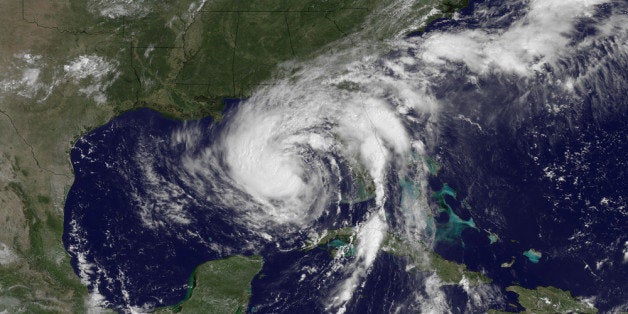
This post was co-authored with Steve Winkelman, Director of Transportation and Adaptation programs at the Center for Clean Air Policy.
Albert Einstein defined insanity as doing the same thing over and over again and expecting different results. Unfortunately, that aptly describes the federal government's fiscally short-sighted response to climate change and its impacts, such as more droughts, wildfires and severe storms.
There is one new reason for hope. President Obama's newly introduced budget sets aside $1 billion for a Climate Resilience Fund. While the President's budget faces some vehement congressional opponents, lawmakers can put their constituents' well-being first by approving this fund.
What's the problem?
For too long, the nation has been failing over and over again to make proactive investments that prepare for -- and protect against -- the effects of a changing climate. As a result, communities across the country are increasingly vulnerable to dangerous and costly weather events, from floods sweeping through Iowa to hurricanes battering the Gulf and East coasts. Nowhere is the need for solutions more evident than in California, where the U.S. Forest Service predicts a record year for wildfires and the ongoing historic drought has brought a severe water shortage, prompting the Governor to sign a nearly $700 million relief package on March 1.
The Climate Resilience Fund would support research on projected climate change impacts, assistance for communities to plan and prepare for these impacts, and new technologies and infrastructure to make communities more resilient to the shocks and stresses of changing conditions. The fund would unlock significant investment to better protect America's coastal areas that generate 51 million jobs and 45 percent of the nation's GDP. It also would expand resilient energy infrastructure, like smaller-scale renewable power generation and microgrids that are effective in providing electricity to communities and businesses during weather disasters. The bottom line is that this fund will make an important start in safeguarding people, their homes, and their businesses in a challenging and uncertain future.
There's no question that this Climate Resilience Fund is sorely needed. Over the past three years, the United States suffered 32 different billion-dollar climate and weather-related disasters. Costing over $200 billion, these included deadly wildfires and widespread drought, severe storms like Hurricane Sandy, and record flooding such as in Colorado. The number of annual federal disaster declarations rose from 68 in 2004 to 99 in 2011, requiring FEMA to allocate $80 billion for disaster aid. Following Hurricane Sandy in 2012, Congress provided $60 billion for disaster assistance. The costs of these disasters have put taxpayer-funded government programs like the National Flood Insurance Program and the Crop Insurance Corporation in deep debt.
The mounting toll underscores the necessity of investing to make the nation more resilient in the face of climate change. It's also just good economics. Every $1 invested now in making communities stronger delivers at least $4 in costs saved from weather-related disasters later. Moreover, the ability of businesses to operate during and after severe weather events is critical to economic vitality. Fully 40 percent of businesses affected by extreme events for extended periods of time never reopen, according to the Business Continuity Institute. In recent Senate testimony, Federal Reserve Chair Janet L. Yellen linked the sluggish economic recovery in recent months with the severe weather plaguing our country.
The money in the Climate Resilience Fund will enable successful, underfunded state and local efforts to grow. For instance, California's leadership will be supported. In its draft Water Action Plan, California calls for increasing water recycling and improving flood protections to expand water storage capabilities. In December, Los Angeles became the first major U.S. city to require "cool" roofs on new and refurbished homes. These cool roofs reflect sunlight and heat to keep the roof surface cooler, thereby reducing energy use for air conditioning and lowering health risks from extreme heat exposure.
On the East Coast, Delaware replenished beaches with sand to help protect the state's multi-billion tourism industry from storm impacts. Beach nourishment is one tool that the state uses in implementing a comprehensive shore protection strategy, and Delaware estimates that for every $1 it invests in shore protection, it receives at least $10 in storm protection value. Protective measures work and "prove the old adage that an ounce of prevention is worth a pound of cure," said Collin O'Mara, Delaware's secretary of the environment and energy.
While we can't ask Einstein for help in preventing the toll from climate change, it does not take a genius to see that investing to make the nation stronger is a wise decision. It's time for Washington to end its cycle of failure and advance the Climate Resilience Fund. It's a vital step toward safeguarding our communities and the economy.
--
Vicki Arroyo is the Executive Director of the Georgetown Climate Center at Georgetown Law where she also teaches and directs Georgetown Law's Environmental Law Program. She previously served as Vice President and General Counsel of the Pew Center on Global Climate Change. Her TED talk on climate adaptation has been viewed more than 750,000 times.
Steve Winkelman is Director of Transportation and Adaptation Programs at the Center for Clean Air Policy, where his work focuses on the intersections among urban planning, climate policy, economics and public-private collaboration. He is co-author of Growing Wealthier: Smart Growth, Climate Change and Prosperity.